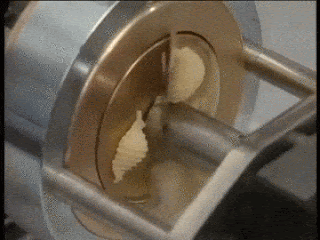Well, yes, my little Mensa friends, but WHY does one pasta cost significantly more than the other?
Is it the packaging? The name brand? The number of curlicues per square foot?
It's two things, actually: the wheat used to make the flour, and the machinery on which it is cut. Let's look at both of these factors individually.
Every heard of Durum wheat? It's what's called a "hard" wheat, which means it contains more proteins than soft wheat, especially gluten. When ground, durum wheat becomes semolina, and durum flour, the only two dry ingredients used in Italian pasta. Semolina flour helps the pasta stay firm when cooked, and is also higher in protein than all-purpose flour.
Good flour and pure, clean water. These are the first two ingredients to high quality pasta.
Now, let's talk about cutting this good quality pasta dough. Pasta is cut by machine, using "die".
Remember that Play-Doh set with the extruder? You could change the plates and make different shapes. Well, pasta machines do pretty much the same thing. Each die produces a different shape, when the pasta dough is pushed through them. As the shape comes out, a blade spins and cuts the noodle at the desired length. Long cuts, like spaghetti or linguini, are great for olive oil based sauces, or full-bodied tomato sauces. Short cuts, like penne, rotini, or farfalle, are better for chunky ragus or vegetable sauces. The last group are the soup cuts. These are the little guys, like ditalini, or acini di pepe. They go best in soup, or as a side dish.
Teflon, as we all know, is a nonstick surface. When die are coated with Teflon, the pasta dough slides through quickly, easily, and cleanly, which makes it ideal to produce massive amounts of macaroni in less time. However, because it slides through so easily, the surface of the noodle is smooth. Now, that looks nice, but when the pasta is cooked and tossed with sauce, the sauce won't cling to the noodle. It just slides off. (This is where you conjure up memories of the spaghetti you had in the school cafeteria when you were a kid.) Are you now saying to yourself "wow, now I know why I can't get the sauce to cling to my pasta?" Good for you!
Now, pasta that is pushed through the bronze die takes more time to produce, since it has to go through more slowly than if it was passing through the Teflon. Going through bronze leaves a rough surface on the noodle. When cooked, these little nicks on the surface hold the sauce onto the pasta.
Voila!
Oh...you thought I was finished with the story? NOPE. One more piece to the puzzle. THEN I'll stop talking.
Let's review: Quality ingredients=better pasta. Teflon=slippery noodle. Bronze=rough surface, holds sauce. Got that so far?
The last, but not least, important factor to quality pasta is how the noodle is dried after it is produced. Most of the mass produced, Teflon extruded, lower quality pasta is dried quickly, at hotter temperatures, usually between 140-190 degrees. At 140, the starch molecules open, and you get what is called the "Maillard Reaction". This is a culinary term for the chemical reaction that happens when food begins to brown or toast. This is why the cheaper pasta often looks more yellow. This makes it attractive to the eye, but, when cooked. loses flavor, and because some of the original water is left in the noodle, overcooks more easily. (Again, cafeteria spaghetti)
Bronze cut pasta is more likely to be slow dried, at temperatures closer to 104 degrees. This takes much longer, up to 30 hours, but the pasta retains more of the nutty flavor and aroma of the durum wheat. It's also much lighter in color than the quick dried stuff, but it makes it much harder to overcook. If properly cooked (al dente), you will get a tiny white spot, right at the center of the noodle, which is sometimes called the "white ghost". The pasta remains firm, the sauce clings to the surface, and all is right with the world.
Let's tie this whole thing up, shall we? Seems like an awful lot of talking about macaroni!
Good pasta begins with quality ingredients, is pushed through bronze die, and is dried slowly. Ergo, it tends to cost more. Have you tried any? It's totally worth it. Give it a go sometime.
Thanks for your time. Hope you learned something useful. I mean, that's what I strive for here on these pages. I'm going to get back into posting more often. It feels good to write again.
Now go get some good pasta and get cooking!

